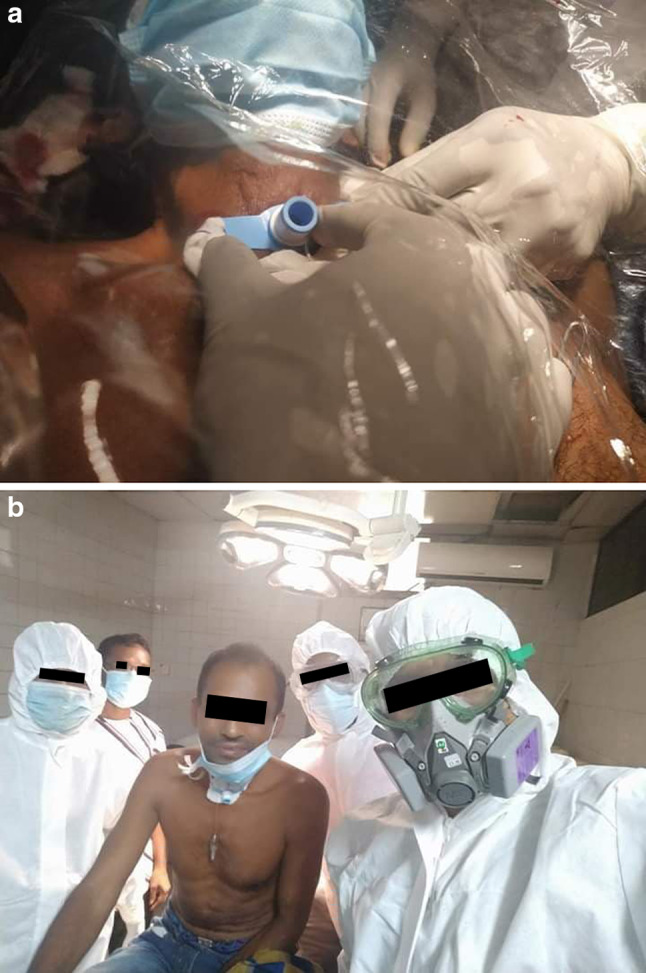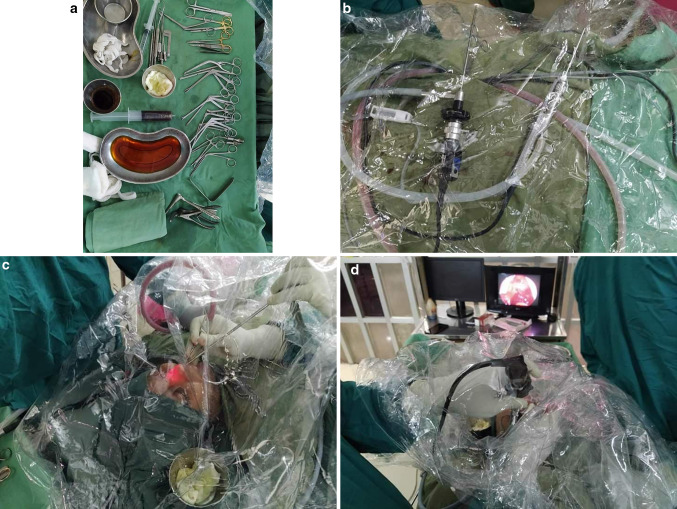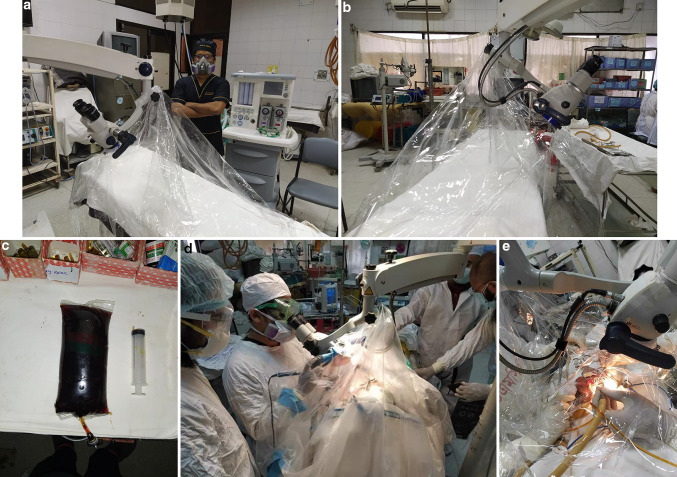Abstract
Health care providers (HCP) of ENT and Skull base surgery are highly vulnerable and mostly infected by novel coronavirus as they have to examine and perform procedures directly in oral cavity, oropharynx, nose, nasopharynx, where coronavirus remains in plenty. ENT & Skull base surgeons need to do several aerosol generating procedures (AGP). Most of the endoscopic and microscopic ENT & skull base surgery are AGP; like—mastoid surgery, sinus surgery, surgery of pituitary, tympanomastoid paraganglioma, temporal bone malignancy, tracheostomy etc. All of we know, COVID negative by RT—PCR test is not always COVID negative. In COVID-19 pandemic—routine, even cancer surgeries are avoided or postponed for the sake of safety of HCPs. Moreover, in case of surgical emergency there’s no way to refuse a patient for not having a report of COVID test. We thought about neutralizing or destroying the novel coronavirus from it’s route of entry zone, as well as preventing aerosol to be transmitted in the air of OT. We designed a novel approach, i.e. ‘POLIDON’ (POLIDON = Polythene + Povidone Iodine), which can be the solution for these patients as well as surgeons or HCPs of above mentioned specialties. Use of Povidone Iodine as mouthwash and nasal spray or irrigation for both patient and HCPs prior to surgery is proposed. Then, use of simple polythene as barrier drape of patient or operative area for prevention of spread of aerosol in OT during surgery is the other component. With the POLIDON’ approach—all these ENT & skull base surgeries can be done with more safety and confidence.
Keywords: POLIDON, COVID-19, ENT, Skull base, Health care provider
Introduction
In March 2020 WHO declared COVID-19 as pandemic. Throughout the world huge number of health care providers (HCP) are infected and died due to COVID-19 [1]. Among them HCP of ENT, Skull base surgery, Dental or maxillofacial surgery, anaesthesia or ICU Department are highly vulnerable and mostly infected; as they have to examine and perform procedures directly in oral cavity, oropharynx, nose, nasopharynx and middle ear i.e. the area containing the respiratory epithelium [2, 3]. Coronavirus remains in plenty in saliva of oral cavity and much more in nasopharynx [4–6].
ENT & Skull base surgeons need to do several aerosol generating procedures (AGP). Most of the endoscopic and microscopic ENT & skull base surgery, where, micromotor drill and microdebriders are used, are AGP; like—mastoid surgery, sinus surgery, surgery of pituitary, tympanomastoid paraganglioma, temporal bone malignancy etc. [7–9].
From the pathological point of view—Coronavirus enters in human body through nose or mouth mainly via respiratory droplet or aerosol from infected person, stays there for a while, then binds with ACE2 receptor of epithelium, enter into the cell, multiply and manifests [2, 10]. We thought about neutralizing or destroying the novel coronavirus from it’s route of entry zone [11, 12].
All of we know, COVID negative by RT—PCR test is not always COVID negative. RT-PCR test is not 100% sensitive or specific, rather it has 30 to 40% false negative report. For this, in COVID-19 pandemic routine, even cancer surgeries are discouraged, avoided or postponed for the sake of safety of HCPs. Sufferings of the patients are unbearable. Moreover, in case of surgical emergency there’s no way to refuse a patient for not having a report of COVID test [2, 12]. Again, patients are not interested to do a COVID test routinely in several countries, specially in resource constraint countries, where testing is not very easy and expensive in some extent.
We designed and proposed a novel approach, i.e. ‘POLIDON’ (POLIDON = Polythene + Povidone Iodine), which can be the ultimate hope or solution for these unfortunate patients as well as surgeons or HCPs of above mentioned specialities [2]. Firstly, Use of Povidone Iodine as mouthwash and nasal spray or irrigation for both patient and HCPs prior to surgery is proposed for destruction or elimination of coronavirus from nose and mouth for the prevention of transmission of coronavirus from one to others [11, 13, 14]. Secondly, use of simple polythene (or alternatively microscope drape) as barrier drape of patient or operative area for prevention of spread of aerosol in OT during surgery is proposed [2, 8, 15]. POLIDON approach is designed for mainly ENT and Skull base Surgery. HCPs of dental surgery and anaesthesia can be benefitted by this approach also.
Povidone Iodine /PVP-I
PVP-I has been shown to be active in vitro against the coronaviruses that have caused epidemics in the last two decades, namely SARS-CoV causing the severe acute respiratory syndrome (SARS) epidemic of 2002–3 and MERS-CoV the agent responsible for causing the Middle East respiratory syndrome (MERS) epidemic of 2012–13. SARS-CoV-2 is highly homologous with SARS-CoV, and as such it is considered a close relative of SARS CoV. In his study Egger et al. suggests that, upto 0.23% concentration of PVP-I is virucidal [16]. Kariwa showed that treatment in vitro of SARS-CoV with various preparations of PVP-I for 2 min was enough to reduce viral activity to undetectable levels. The lowest concentration used was 0·23%, found in an over the counter throat spray. Recent studies conclude that SARS-CoV-2 should behave similarly [2, 11].
Preparation of Povidone Iodine or PVP-I for Application Prior to Surgery:
For Patients as Well as HCPs:
-
A.
For gargling and mouthwash:
-
(i)
For fully conscious patient & HCPs-
PVP-I 1% solution (undiluted) 10 ml for 30 s to 1 min or 0.5% solution (diluted by mixing same amount of water, i.e. 10 ml PVP-I with 10 ml water) 20 ml for 1–2 min. In case of 10% PVP-I solution, 1 ml can be mixed with 19 ml water to get the same concentration.
-
(ii)
For patient with altered consciousness—A sponge swab or similar is soaked in 2–5 ml of 1% PVP-I and this is carefully wiped around all oral mucosal surface.
-
B.
For nasal application:
Nasal spray: 2–3 puff in each nostril with a standard atomizing devise with 0.5% or 0.6% solution of PVP-I or.
Nasal irrigation: Irrigate or wash through both nostril with 200–300 ml (100–150 ml in each nostril) of 0.5% PVP-I solution or.
Nasal drop: If nasal spray or irrigation facility is not available apply nasal drop 3–4 drops in each nostril [2, 11, 13].
Preparation of PVP-I Mixed Irrigating Fluid (for mastoidectomy, FESS and Skull Base Surgery)
100 ml of PVP-I 10% solution is to be mixed with 1000 ml of Normal saline to make a PVP-I 1% solution [2].
Polythene
Simple, transparent polythene can act as barrier drape which is an interface between HCP and patient or operative area. Polythene is proved effective in several studies (as barrier for virus or other particle) in preventing spread of aerosol, produced in these surgeries.
The polythene sheet allows good mobility of the hands of the surgeon’s.
In case of endonasal endoscopic sinus or anterior skull base surgery a stand/ frame can be used to (up) hold the polythene drape for the comfort of the surgeon. Otherwise, covering the patient from head to waist or mid thigh with a polythene is enough (Fig. 1) [9].
Fig. 1.
POLIDON technique in FESS or anterior skull base surgery (a) Trolley of FESS (b) endoscope, camera, microdebrider etc. were kept on patient’s body,covered by polythene (c) patient is covered with polythene (d) during surgery
In case of tracheostomy, placing a polythene just prior to opening the trachea is vital to prevent aerosol or droplet spread in Operation theatre (Fig. 2) [12].
Fig. 2.

POLIDON approach in Tracheostomy (a) prior to opening of trachea operative field was covered with polythene sheet (b) Immediately after Emergency Tracheostomy (consent was taken from patient for publishing photo)
We designed a technique to use it like ototent (please see figure) for ear surgery, specially mastoidectomy and lateral skull base surgery (Fig. 3) [2].
Fig. 3.
POLIDON approach in Mastoidectomy or Lateral skull base surgery (a) Ototent made by polythene/ microscope drape (b) Polythene is fixed with Objective Lens and another point by creating hole in this polythene sheet and fixing it with micropore (c) Irrigating fluid mixed with Povidone Iodine Solution (d) during surgery (e) During surgery (close view) PVP-I mixed irrigating fluid is being used
Similarly, covering the patient or certain area of patient with polythene in tonsillectomy, septal surgery, other nasal surgery and laryngeal surgery (according to need) is needed (Fig. 4).
Fig. 4.

POLIDON technique in Tonsillectomy
In spite of being transparent or translucent, there may have some degree of glare. Limitation of freedom of movement of surgeon and assistant, in some extent, is the main drawback of this approach.
Several modifications can be done. Our focus is on the simplest method. Any positive modification is appreciable.
(Availability of materials, excellent safety profile, associated low cost—are the main benefits.) Polythene and Povidone Iodine both are readily available, cheap and safe to use.
In several institute, especially in Dhaka Medical College Hospital, we are practising this technique for the last four months (since May). Almost all type of ENT and skull base procedures are being performed with this technique. Two of our patients, underwent emergency tracheostomy, were diagnosed as COVID—positive just following surgery. Three nearby patients as well as two attendants were infected by them within one day of hospital stay (in non-COVID unit). Interestingly, among twelve different health care providers, including doctors, nurses and OT staffs, directly involved and exposed in these two surgeries, none of them were infected/were not infected. Importantly, ‘POLIDON’ approach was followed in both the procedures.
Combining these two additional things to the conventional surgery, i.e. our ‘POLIDON’ approach -all these ENT & skull base surgeries can be done with more safety and less fear. Let us do these aerosol generating procedures without hesitation for the betterment of the patient and with more confidence and safety for the health care providers.
Compliance with Ethical Standards
Conflict of interest
All of the authors declare that they have no conflict of interest.
Ethical Approval
Prior to the study ethical approval was acquired from Ethical review committee of Dhaka Medical College and Hospital.
Informed Consent
All of the patients or their attendants gave written informed consent to participate in the study willingly without any prejudice.
Footnotes
Publisher's Note
Springer Nature remains neutral with regard to jurisdictional claims in published maps and institutional affiliations.
References
- 1.Khalil MM, Alam MM, Arefin MK, et al. Role of personal protective measures in prevention of COVID-19 spread among Physicians in Bangladesh: a multicenter cross-sectional comparative study. SN ComprClin Med. 2020 doi: 10.1007/s42399-020-00471-1. [DOI] [PMC free article] [PubMed] [Google Scholar]
- 2.Arefin MK, Uddin MB, Haque MM, Azam MG. ‘POLIDON’ approach—a novel approach of mastoidectomy in the COVID-19 pandemic. On J Otolaryngol & Rhinol. 2020;3(3):1–8. [Google Scholar]
- 3.Pitkäranta A, Jero J, Arruda E, Virolainen A, Hayden FG. Polymerase chain reaction-based detection of rhinovirus, respiratory syncytial virus, and coronavirus in otitis media with effusion. J Pediatr. 1998;133(3):390–394. doi: 10.1016/S0022-3476(98)70276-8. [DOI] [PMC free article] [PubMed] [Google Scholar]
- 4.To KK-W, Tsang OT-Y, Yip CC-Y, et al. Consistent detection of 2019 novel coronavirus in saliva. Clin Infect Dis. 2020;361:1319. doi: 10.1093/cid/ciaa149. [DOI] [PMC free article] [PubMed] [Google Scholar]
- 5.Zou L, Ruan F, Huang M, et al. SARS-CoV-2 viral load in upper respiratory specimens of infected patients. New Engl J Med. 2020;382:1177–1179. doi: 10.1056/NEJMc2001737. [DOI] [PMC free article] [PubMed] [Google Scholar]
- 6.Yoon JG, Yoon J, Song JY, et al. Clinical significance of a high SARS-CoV-2 viral load in the saliva. J Korean Med Sci. 2020;35(20):195. doi: 10.3346/jkms.2020.35.e195. [DOI] [PMC free article] [PubMed] [Google Scholar]
- 7.Norris BK, Goodier AP, Eby TL. Assessment of air quality during mastoidectomy. Otolaryngol Head Neck Surg. 2011;144(3):408–411. doi: 10.1177/0194599810394967. [DOI] [PubMed] [Google Scholar]
- 8.Carron JD, Buck LS. A simple technique for droplet control during mastoid surgery. JAMA Otolaryngol Head Neck Surg. 2020;28:e201064. doi: 10.1001/jamaoto.2020.1064. [DOI] [PMC free article] [PubMed] [Google Scholar]
- 9.Ioannidis D, Tsagkovits A, Rokade A. Minimising aerosol spread during endoscopic sinus and skull base surgery. Experimental model evaluation of the efficacy of the microscope drape method. J Laryngol Otol. 2020 doi: 10.1017/S0022215120001838. [DOI] [PubMed] [Google Scholar]
- 10.Wu C, Zheng M. Single-cell RNA expression profiling shows that ACE2, the putative receptor of Wuhan 2019-nCoV, has significant expression in the nasal, mouth, lung and colon tissues. Preprints 2020. www.preprints.org (accessed 9 April 2020).
- 11.Kirk-Bayley J, Challacombe S J, Sunkaraneni V S, Combes J. The use of povidone iodine nasal spray and mouthwash during the current COVID-19 pandemic may reduce cross infection and protect healthcare workers. 4 May 2020. Available at https://www.researchgate.net/publication/340320238_The_Use_of_Povidone_Iodine_Nasal_Spray_and_Mouthwash_During_the_Current_COVID-19_Pandemic_May_Protect_Healthcare_Workers_and_Reduce_Cross_Infection (accessed June 2020).
- 12.Arefin MK, Uddin MB, Islam MZ, Arafat MS. Novel technique of tracheostomy in the era of novel coronavirus. IJISRT. 2020;5(5):1149–1154. [Google Scholar]
- 13.Mady LJ, Kubik MW. Consideration of povidone-iodine as a public health intervention for COVID-19: utilization as personal protective equipment for frontline providers exposed in high-risk head and neck and skull base oncology care. Oral Oncol. 2020;105:104724. doi: 10.1016/j.oraloncology.2020.104724. [DOI] [PMC free article] [PubMed] [Google Scholar]
- 14.Khan MM, Parab SR, Paranjape M. Repurposing 0.5% povidone iodine solution in otorhinolaryngology practice in Covid 19 pandemic [published online ahead of print, 2020 Jun 18] Am J Otolaryngol. 2020;41(5):102618. doi: 10.1016/j.amjoto.2020.102618. [DOI] [PMC free article] [PubMed] [Google Scholar]
- 15.Heller W, Mitchell T, Thomas S. Mastoidectomy in the COVID era - the 2 microscope drape method to reduce aerosolization. https://www.entuk.org/sites/default/files/Mastoidectomy%20in%20the%20COVID%20Era%20%E2%80%93%20The%202.pdf. Accessed April 20, 2020
- 16.Eggers M, Koburger-Janssen T, Eickmann M, Zorn J. In vitro bactericidal and virucidal efficacy of povidone-iodine gargle/mouthwash against respiratory and oral tract pathogens. Infect Dis Ther. 2018;7:249–259. doi: 10.1007/s40121-018-0200-7. [DOI] [PMC free article] [PubMed] [Google Scholar]




